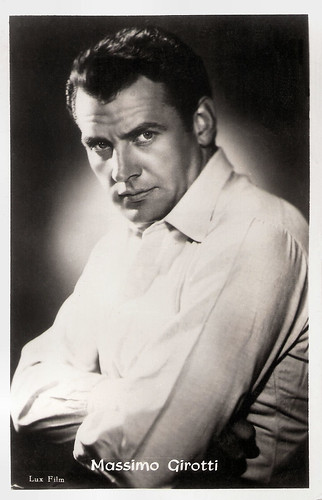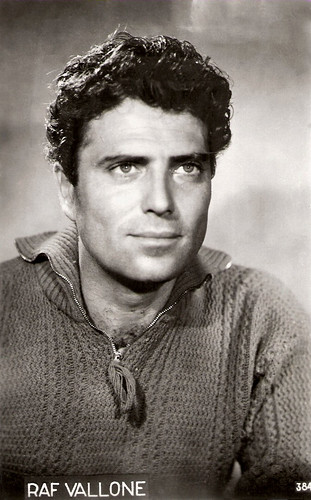Only decades after his death, Germi was finally and rightly recognised as one of Italian cinema’s greats. His pessimistic vision of human relations took shape through a highly original reworking of genres: from the Western like In nome della legge/In the Name of the Law (1949), the first film ever made about the mafia, to melodrama like Il ferroviere (1956), Film Noir like La città si difende (1951), detective mystery like Un maledetto imbroglio (1959) and black comedy like Divorzio all’italiana (1961). Germi never claimed to be an auteur and remained faithful to a vocation as a popular filmmaker. He consistently emphasised the perfectly written screenplay, the mise-en-scene, the film’s rhythm, and the direction of his actors. For this EFSP post, we chose twelve postcards of Germi's leading actors.

Small Czech collector card by Pressfoto, Praha (Prague), 1965, no. S 83/6. Stefania Sandrelli and Marcello Mastroianni in Divorzio all'italiana/Divorce, Italian Style (Pietro Germi, 1961).
In 1961, Pietro Gwermi stunned audiences and critics alike with his biting, satirical and grotesque comedy Divorzio all'italiana/Divorce, Italian Style (1961). Germi won the Oscar for Best Original Screenplay and earned a Best Director nomination at the 35th Academy Awards. Stefania Sandrelli (1946) was 15 years old when she had her breakthrough in this Commedia all’italiana. Her co-star, Marcello Mastroianni (1924-1996) almost singlehandedly defined the contemporary type of Latin lover, then proceeded to redefine it a dozen times and finally parodied it in films like Divorzio all'italiana and played it against type.

German postcard for Das Programm von Heute, Berlin, by Ross Verlag. Photo: Difu.
Elisa Cegani (1911–1996) was one of the most representative actresses of Italian cinema of the thirties and forties. She was the leading lady, a pianist in the comedy Retroscena/Backstage (Alessandro Blasetti, 1939) for which 25-year-old Pietro Germi co-wrote the screenplay. Germi studied at the Centro Sperimentale di Cinematografia in Rome and attended Blasetti's directing courses. Retroscena was a flop and Blasetti always considered it the worst film of his career.

Italian postcard by Bromofoto, Milano (Milan), no. 981. Photo: ENIC.
Italian actress Marina Berti (1924-2002) was a popular starlet in Italian films in the 1940s and early 1950s. She was the leading lady in the psychological thriller Il testimone/The Witness (1946), Pietro Germi's debut as a director. Already evident here is Germi's skill with actors. He puts Berti's sensitivity and delicate beauty to good use in the film as Linda, a newly-married woman whose husband Ernesto is showing increasingly irrational behaviour. Unbeknown to her he has a skeleton in the closet. Germi's early films were in the Neorealist style though a psychological thriller was quite unusual in the years of Neorealism. Many of his other films were social dramas dealing with contemporary issues of people of Sicilian heritage.

Italian postcard, no. 3. Photo: Lux Film. Carla del Poggio in Gioventù perduta/Lost Youth (Pietro Germi, 1948).
Italian actress Carla Del Poggio (1925-2010) was the female star of Federico Fellini’s bittersweet film debut Luci del varietà/Variety Lights (1950). In the 1940s and 1950s, she also starred in films by other famous directors such as Vittorio De Sica, her husband Alberto Lattuada, and Pietro Germi. The crime drama Gioventù perduta/Lost Youth (Pietro Germi, 1948) was Germi's second film. Del Poggio stars as the sister of a psychopath (Jacques Sernas) who leads students into crime. This crime film is also a study of how family and friends can be completely blind to a sociopathic killer in their midst.

Italian card. Photo: Lux Film.
Handsome, manly Italian actor Massimo Girotti (1918-2003) had a career that spanned seven decades. He starred in Luchino Visconti's Ossessione, Michelangelo Antonioni's Cronaca di un amore and Visconti's Senso. He also appeared in a few films by Pietro Germi. He plays in In nome della legge/In the Name of the Law (Pietro Germi, 1949) a young, by-the-book judge who is appointed to a Sicilian village controlled by corrupt leaders and the Mafia. Germi was obviously influenced by the Western: how the Mafia ride into town, shotguns at their backs, Carlo Rustichelli's English-horn-dominated music raising the blood, while the hero is about to stand off the gang of bandits. In nome della legge won three Silver Ribbons and was a box-office hit.

French postcard by Editions P.I., Paris, no. 14 E/384.
In the year after the international box office success of Riso Amaro/Bitter Rice (1949) propelled Raf Vallone (1916-2002) into international stardom, he starred as a desperate immigrant in Pietro Germi's Neorealist drama Il cammino della speranza/The Path of Hope (Pietro Germi, 1950). This powerful, monumental film was inspired by a novel by Nino di Maria and had a screenplay by Federico Fellini, Tullio Pinelli and Germi. Germi handled the burgeoning relationship between two Sicilian immigrants (Vallone and his wife Elena Varzi) beautifully and sensitively. The film was presented in competition at Cannes and won the Silver Bear and the Golden Bear at the Berlin Film Festival.

German postcard, no. 15. Sent by mail in the Netherlands in 1961. Collection: Geoffrey Donaldson Institute.
Gorgeous Gina Lollobrigida (1927-2023) was the leading lady of the interesting and effective Film Noir La città si difende/Four Ways Out (Pietro Germi, 1951). Germi followed the results of a big robbery in a different way. Instead of focusing on how the police try to track down the robbers, Germi concentrated on how the crime affects the lives of the thieves and their families. He brought the story alive with several nice cinematic touches, cross-cutting, solid character acting and a tense, emotional finale. Fellini, Pinelli and Germi wrote again the script, this time with the assistance of Giuseppe Mangione and Luigi Comencini. La città si difende was awarded Best Italian Film at the Venice Film Festival.

Italian postcard by Rotocalco Dagnino, Torino. Photo: LIF / Cines / Lux Film / Rovere Film. Amedeo Nazzari in Il Brigante di Tacca del Lupo/The Bandit of Tacca Del Lupo (Pietro Germi, 1952).
Italian heartthrob Amedeo Nazzari (1907-1979) was the athletic, fearless hero and impeccable gentleman of dozens of popular films during the late 1930s, 1940s and 1950s. Because of his reckless, adventure-seeking film characters, he was compared to Errol Flynn. He was the male star of Il Brigante di Tacca del Lupo/The Bandit of Tacca del Lupo (Pietro Germi, 1952). Nazzari played the captain of a small force of soldiers in 19th-century southern Italy (near Melfi, Basilicata). They fight in the hills against the bandits who hold their country to ransom.

Italian postcard by Rotocalco Dagnino, Torino. Photo: LIF / Cines / Lux Film / Rovere Film. Cosetta Greco in Il Brigante di Tacca del Lupo/The Bandit of Tacca del Lupo (Pietro Germi, 1952), based on the novel by Riccardo Bacchelli. Publicity card for the Manzoni cinema, Turin, where the film ran from 21 November [1952] onwards.
Italian actress Cosetta Greco (1930-2002) appeared in 31 films between 1943 and 1971. She is famous for Germi's Il brigante di Tacca del Lupo (1952), but also for films like Le ragazze di piazza di Spagna/Three Girls from Rome (Luciano Emmer, 1952), Gli eroi della domenica/Sunday Heroes (Mario Camerini, 1953), and Cronache di poveri amanti/Chronicle of Poor Lovers (Carlo Lizzani, 1954).

Italian postcard by B.F.F. Edit., no. 2779. Photo: Minerva Films.
Handsome Erno Crisa (1914-1968) starred in Pietro Germi's drama Gelosia/Jealousy (1953). He played a Sicilian nobleman, jealous of his mistress, a farmhand's daughter. When she gets married to his lieutenant, he commits a murder of which an innocent man is accused. The guilty Marchese is tormented by his conscience and hears the dead man singing outside his villa. A moving and overwhelmingly impressive masterpiece, according to an IMDb reviewer.

Italian postcard by Rotalcolor, no. 20.
Sylva Koscina (1933-1994) played Giulia the unmarried pregnant daughter of railroad engineer Andrea Marcocci (Pietro Germi) in the melodrama Il ferroviere/The Railroad Man (Pietro Germi, 1956). After a suicide crosses the tracks of his train in a curve, Andrea feels deeply affected by the accident and almost collides with another train. The railroad company investigates the accident and steps Andrea down from his position. At home, his aggressive behaviour causes Giulia and her older brother to leave home. Andrea starts to drink until the day his youngest son Sandrino visits him in a bar. Il ferroviere rises above the limitations of soap operas through the beauty of the characterisations and the quality of the performances. Most of the film is from the viewpoint of Andrea, but in an odd twist, 7-year-old Sandrino (Edoardo Nevola) sometimes narrates what is happening around him. Nevola's performance is awesome. Il ferroviere was a huge popular success and is considered one of the last masterpieces of Italian Neorealism.

Dutch postcard.
Claudia Cardinale (1938) is one of Europe's iconic and most versatile film stars. At the start of her career, she co-starred with Pietro Germi in his well-constructed and highly entertaining police mystery Un maledetto imbroglio/The Facts of Murder (Pietro Germi, 1959). The plot, about a robbery in one apartment, and a murder in an apartment across the hall a week later, is as complex as a Raymond Chandler novel, with a similar denouement. It's richly detailed, with many interesting characters. Germi is a superb actor and his handling of other actors is sure. The pace is fast but not rushed, and the writing and the photography are richly nuanced.

East-German postcard by VEB Progress Film-Vertrieb, Berlin, no. 2869. Retail price: 0,20 MDN.
Through the years, Pietro Germi shifted away from social drama towards satirical comedies but retained his beloved element of the Sicilian people. He received worldwide success with the black comedies Divorzio all'italiana/Divorce, Italian Style (1961), Sedotta e abbandonata/Seduced and Abandoned (1964), and Signore & signori/The Birds, the Bees and the Italians (1966). Virna Lisi (1936-2014) was the leading lady of Signore & signori (Pietro Germi, 1966). The film contains three stories, all set in fictional in small-town Rezega but filmed in Treviso. Various couples experience adultery at a party, a bank clerk abandons his wife for his mistress and all the men in the end are prosecuted for having intercourse with an underage girl. But "si fa ma non si dice" (everybody does it, nobody tells about it) is the law. This forgotten film is one of the best examples of the Commedia all’italiana and won the Palme d'Or at the Cannes Film Festival.

French postcard by Dark Star. Image: French poster for the 2009 re-issue of Signore & Signori (Pietro Germi, 1966) with Virna Lisi.
Sources: Il Cinema Ritrovato, Wikipedia (English and Italian) and IMDb.
No comments:
Post a Comment